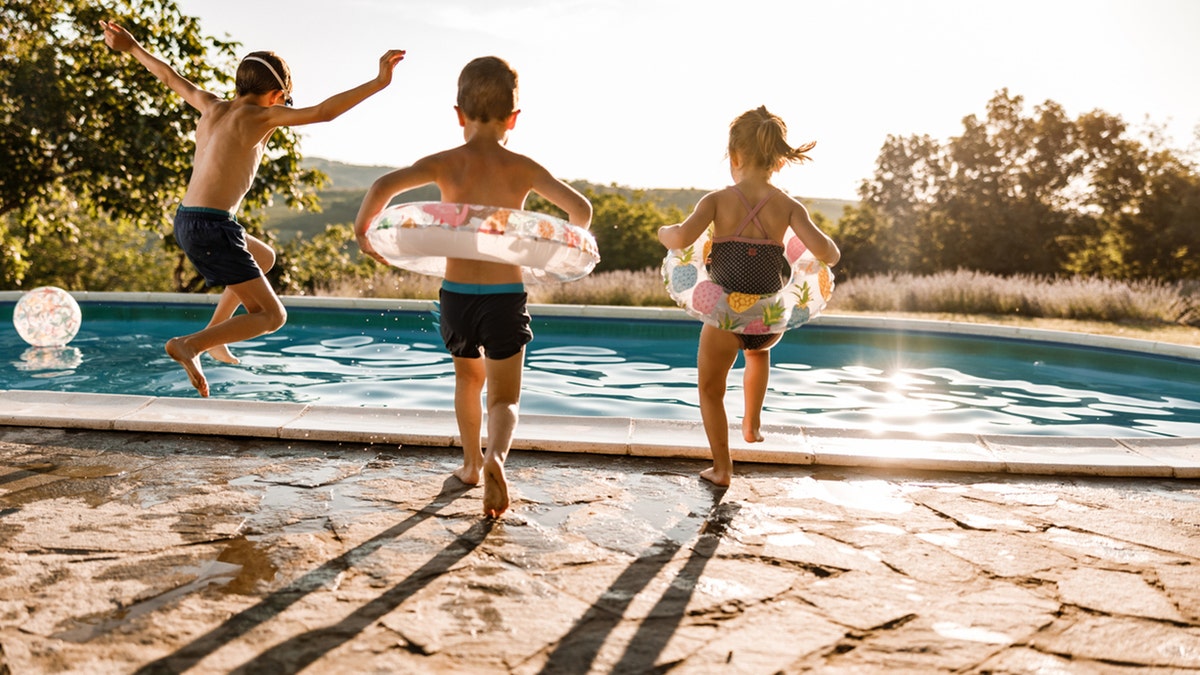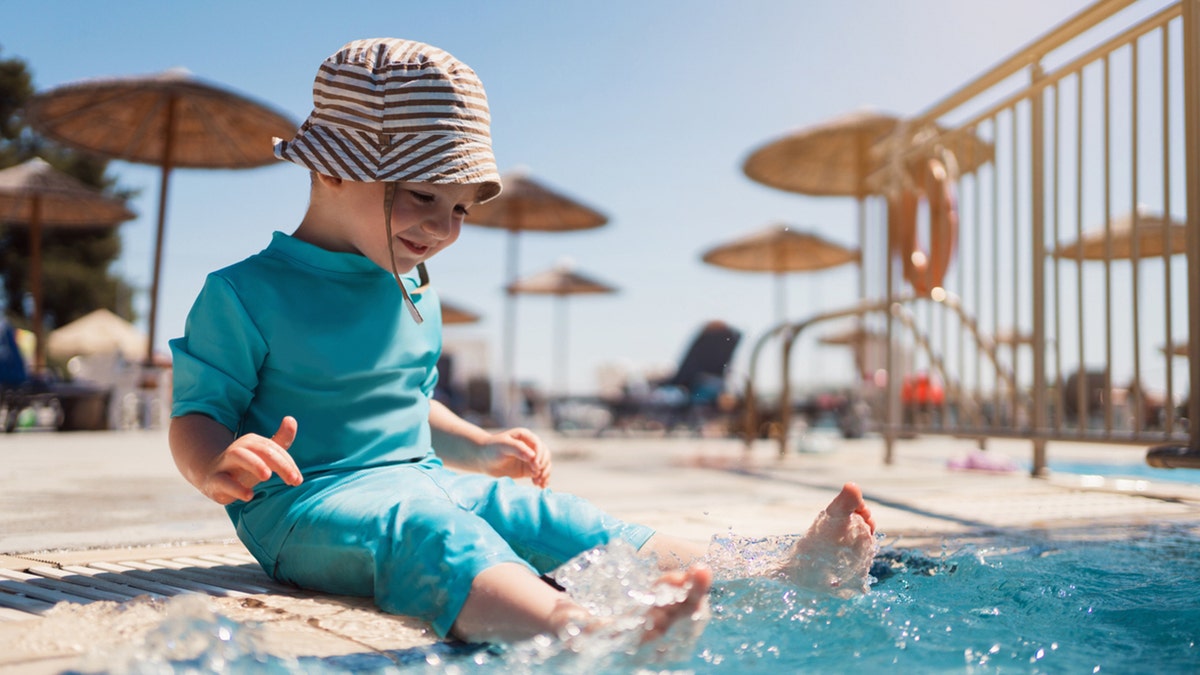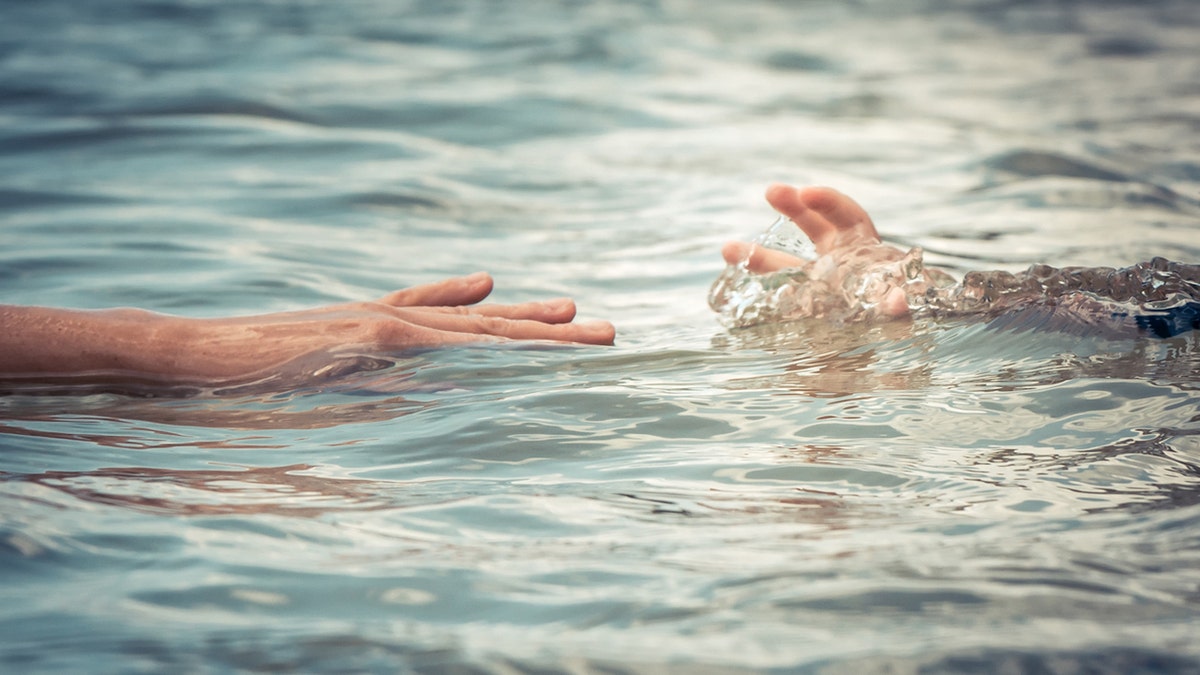
When the warm summer weather arrives, the pool covers are pulled open and a cooling dip becomes a regular part of the season.
Since swimming pools and summer are inextricably linked, now is the perfect time for a refresher course on water safety.
Aside from birth defects, drowning is the leading cause of death among children ages 1 to 4, according to the American Red Cross. Children under 1 are more likely to drown at home, while 87 percent of drowning incidents among children under 5 occur in home pools or hot tubs. As children get older, lakes and ponds become dangerous environments for potential drowning. Children ages 5 to 17 are more likely to drown in natural bodies of water like this one.
GRANGER SMITH'S HUSBAND, AMBER SMITH, IS PARTNERING WITH DROWNING PREVENTION ORGANIZATION TO RAISE AWARENESS
According to Dr. Corinne Bria, a pediatric emergency medicine physician at Nemours Children's Hospital in Orlando, Florida, knowledge is the single most important tool for preventing drowning in children.
“As a pediatrician, it is my responsibility to educate parents and caregivers about how to prevent drowning,” she told Fox News Digital.
BEACH SAFETY TIPS: 7 THINGS TO DO IN A RIPCURRENT AND HOW TO STAY SAFE BY THE WATER
“Drowning can happen to anyone. No one is immune to this devastation, and it is important to be aware and take active steps to ensure water safety.”
Keep children safe in pools and other bodies of water by following these tips.
- Ensure proper supervision
- Choose a suitable float
- Be careful even near shallow water
- Close all pools with fences
- Register your child for swimming lessons
- Act quickly and perform CPR
According to the American Red Cross, drowning is the leading cause of death in children ages 1 to 4 in the U.S., next to birth defects. (iStock)
1. Ensure proper supervision
When it comes to water safety, pediatricians often talk about “direct supervision” or “touch supervision,” Bria says.
She added that these are both important strategies to prevent drowning, which is a silent process.
“Touch supervision involves an adult physically being in the water holding and playing with the children,” Bria said.
“Direct supervision means that there is a designated adult, a water ranger, who is supervising the children in and around the water,” Bria continued. “The water ranger sits at the pool or walks around the pool and is constantly monitoring the children in and around the water.”
When it comes to water, tragedy can happen in a split second, which is why it is so important to keep an eye on children at all times.
2. Choose a suitable floatant
According to the American Academy of Pediatrics (AAP), children should always wear a life jacket when near water.

Always ensure that children are wearing properly fitting flotation devices before entering the pool. (iStock)
The AAP recommends using life jackets or life preservers that are approved by the U.S. Coast Guard, based on the weight of the child.
“It is important to test the fit of the life jacket on the child before using it to ensure the jacket sits properly around the waist,” says Bria.
SWIMMING IN A SHARK'S HOUSE: EXPERT TIPS TO PREVENT AND SURVIVE AN ATTACK
“This prevents [children] by slipping out of a vest that is not the right size while in the water.”
As your child grows, new flotation devices will be needed. Make sure you stay up to date on the right flotation devices to avoid a water tragedy.
3. Be careful even near shallow water
Shallow water does not mean the water is safe.
If your child is in a small pool, such as a garden pool or on a slide with a small pool of water at the bottom, you should keep a close eye on him or her.
Bria pointed out that babies and young children can drown in as little as 2 inches of water, including bathtubs, toilets and five-gallon buckets.
“It is important to supervise infants, toddlers and young children around all forms of water, both inside and outside the home,” she said.
4. Enclose all pools with fences
According to the AAP, babies drown most often in bathtubs and buckets of water. According to the source, most toddler drownings occur in swimming pools.
Closing all swimming pools with a fence is the most effective way to prevent drowning, the AAP says on its website.

A secure fence around a pool can help keep children safe. (iStock)
The fence must have four sides, be at least 1.20 meters high, be resistant to climbing and have an automatic closing gate that children cannot reach.
Remember to always close the gate properly so that a child cannot squeeze through.
BE HEALTHY: RECOGNIZE WARNING SIGNS OF 'DRY DROWNING' AND TAKE QUICK ACTION
This is an easy way to keep your child safe when he or she is outside.
Even if the pool is fenced, it is still important to keep an eye on children, as they could slip through a broken fence.
5. Register your child for swimming lessons
Research has shown that participating in formal swimming lessons reduces the risk of drowning in children aged 1 to 4 years by 88%.
Many children can begin swimming lessons as early as age 1, according to the AAP. For children ages 4 and up, lessons are a “must.”
If your child knows how to swim, such as how to keep his or her head above water in an emergency, this provides an extra layer of protection.
Swimming is a great skill to have, and getting kids started at a young age will help them learn faster and develop better as they get older.
6. Act quickly and perform CPR
Every second counts when you think about drowning. If you see something happening, act as fast as possible and get the child out of the water.
EXPERT WATER SAFETY TIPS FOR FAMILIES AND CAREGIVERS AS DROWNING DEATHS INCREASE
“Remember, drowning is silent and very different from what we see in movies or on TV,” Bria said. “If you find someone underwater, get them out of the water, call 911 and start CPR.”

If you see a child drowning, get him or her out of the water as quickly as possible, call 911 and perform CPR. (iStock)
The procedure for rescuing a drowning child varies depending on the age and size of the child.
“Before puberty, you treat them like adults,” said Steve Conti, a firefighter, paramedic and AHA CPR instructor. “Once you see body hair, you treat them like adults.”
“If you have any questions about water safety, consult your pediatrician.”
Conti recommends that older children should be given at least 100 firm, rapid compressions per minute, using the heel of your palm on the center of the chest, at the base of the breastbone.
You will want to check the carotid artery in the young adolescent's neck for a pulse.
In a young, small child who cannot yet speak or communicate and is not breathing adequately, Conti recommends checking the child's brachial pulse in the arm.
Give 30 compressions per minute with two fingers.
“In children, chest compressions should be a little gentler than in adults,” he said.
“And it's important to avoid inhaling too much air.”
Conti also advises being careful with a child's neck if he or she falls.
CLICK HERE TO SIGN UP FOR OUR HEALTH NEWSLETTER
Children often slip and fall in a pool and unless an adult has witnessed the accident, a head or neck injury without bleeding may not be easily identified. It is best to work as quickly but gently as possible in removing the child from the water.
Knowing how to perform CPR is a start, but learning from a professional and keeping up to date with training can save lives.
For more health articles, visit www.foxnews/health
“Your actions can truly make the difference between life and death, between full recovery and long-term disability,” Conti said. “Regularly refreshing your knowledge and skills in CPR, AED use and water safety can save lives.”
“If you have any questions about water safety, ask your pediatrician,” Bria continued. “This is an important conversation to have.”
CLICK HERE TO GET THE FOX NEWS APP
Drowning can happen to anyone.
“Be intentional and deliberate in identifying and mitigating risks to prevent children from drowning,” Bria said.












